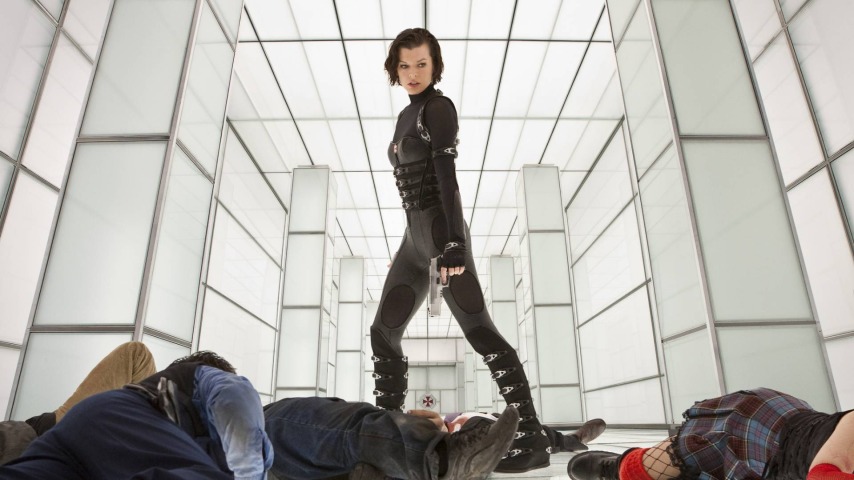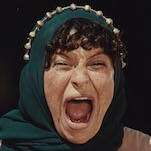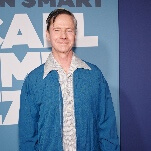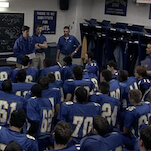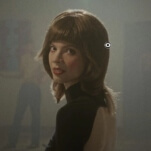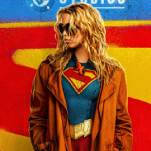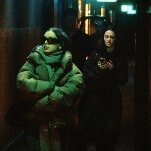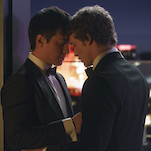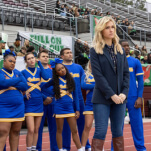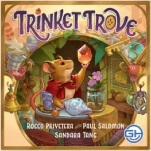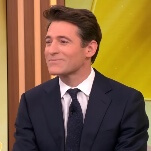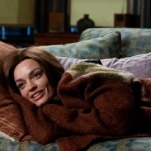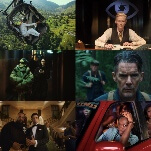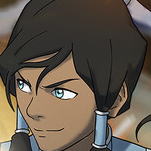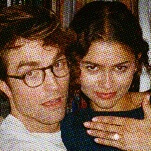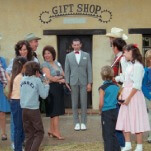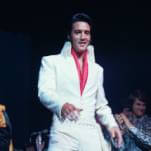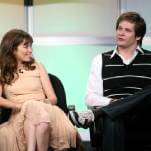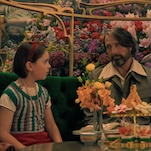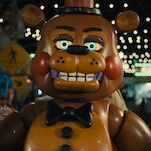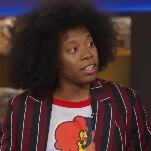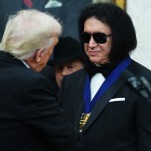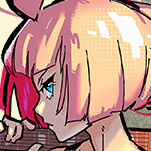With Together Again, Jesse Hassenger looks at actors and directors who have worked together on at least three films, analyzing the nature of their collaborations.
Milla Jovovich was born to be the muse of a doofus. That’s not entirely fair to Jovovich, who is her own person, and must have lived plenty of life before marrying either director Paul W.S. Anderson, who has directed her seven times, or her previous husband Luc Besson, creator and director of her breakthrough role in The Fifth Element. (It’s probably also unfair to Anderson; Besson, you’re on your own.) But putting aside her obvious autonomy, Jovovich’s signature roles do tend to reflect the half-geeky, half-lecherous specifications of a certain kind of popcorn filmmaker.
Initially raised in Moscow, Jovovich emigrated with her family to Los Angeles, where she learned English, dropped out of secondary school, and pursued modeling, acting, music and, by her own admission, occasional low-level crimes. When Besson cast her in The Fifth Element, perhaps he was picking up on a certain alien quality in Jovovich’s affect: the everywhere-yet-nowhere strangeness of having lived in Ukraine, Russia, London, and Los Angeles all before high school. Whatever the reason and however conscious he was of it, Besson saw a decades-younger potential star he could mold to his geek-letch specifications.
Those specifications were no less than the physical embodiment of love in the universe. (Naturally, this also involves kicking ass when necessary, and wearing clothes but only sometimes.) Besson supposedly began working out ideas for The Fifth Element when he was a teenager, and it shows; Leeloo Dallas Multipass is the kind of tough yet waifish beauty that nerds have been fantasizing about for ages, a character who requires elaborate mythological machinations to explain why she comes to pay close attention to whatever normal schlub she’s paired with. (For these purposes, Bruce Willis—also many years her senior—counts as a normal schlub.) To Jovovich’s credit and possible curse, it is nonetheless difficult to picture anyone else in the role.
Besson and Jovovich were married for two years, during which he cast her as no less than Joan Of Arc in The Messenger, failing to launch her career as a serious actress. She returned to genre territory for her next leading role, in the 2002 video game adaptation Resident Evil, directed by Paul W.S. Anderson and beginning another major relationship. He and Jovovich dated on and off before starting a family in 2007 and eventually marrying in 2009. Anderson then resumed directing Resident Evil sequels (he only produced and wrote the second and third films), making just one movie without Jovovich in the past 15 years.
While Jovovich entered into this partnership already something of a geek icon thanks to The Fifth Element, Anderson spent the pre-Jovovich portion of his career gaining a reputation as public enemy number one, providing that you consider Ain’t It Cool News the public; online geek types decried his name as a harbinger of genre-picture doom. Regular critics weren’t especially fond, either, though they took it less personally when he “ruined” video game properties like Mortal Kombat. While he’s still not a consensus critical favorite, it’s somewhat more accepted now that Anderson’s B-movie polish outshines any number of his A-movie equivalents, especially in the age of the bloated, expensive-yet-cheap-looking comic-book spectacular. Anderson composes action scenes with clarity; makes the most of his mise-en-scène, often via distinctive set design; and usually gets everything done in 100 minutes or less. Though it’s possible to extract some thematic meaning from his work, his primary concern seems to be paying tribute to his favorite filmmakers: the vague idea of John Carpenter, and James Cameron if the only movie he ever made was Aliens.
Despite this unpretentious craft, that first Resident Evil does bump up against Anderson’s limits. Most noticeably, it’s not much of a zombie movie. Tellingly and damningly, the most memorable kills are committed by some lasers in a hallway, imagery more memorable and iconic than the soft-R hordes of zombies that paw impotently at our largely interchangeable heroes. Even more telling: It works best as a vehicle for Jovovich’s recovering amnesiac operative Alice to undergo her Ripleyesque transformation from woman in or observing distress to fierce action hero.
Anderson doesn’t exactly specialize in elegant character arcs; as much as he clearly must love Ellen Ripley and Aliens, his Alice comes closer to the cloned version from Alien: Resurrection. Even in the first movie, where it would make sense to get more of a transformation, that change is largely down to Alice recovering enough memories to realize that she’s apparently trained in the art of kicking zombie dogs in the face. (She’s not even the one dodging lasers in this one!) Even without a clear arc, though, the first movie is setting a template for Alice, the malleable yet unbreakable focal point created for the film series. She’s introduced waking up nude, barely draped in a shower curtain, with the foggiest glimmers of memories—a blank slate, in other words, that recalls Jovovich’s inception as Leeloo, as if Anderson is subconsciously announcing his intention to start from scratch (even if he arrives at a similar, if less woo-woo, place of righteous ass-kicking). Variations on this image of Jovovich recur throughout the series, as her makeshift coverings—shower curtain, robe, paper medical gown—become the (nominally) more practical equivalent of Leeloo’s signature high-fashion bandage outfit. To an extent, Anderson is (like Besson) offering an opportunity to ogle Jovovich’s form; he’s also calling the shot that the Resident Evil movies will continue resetting themselves, and Alice, as they continue. This leaves Alice as a more elusive object of fantasy, and Jovovich herself as the constant.
For an in-depth analysis of how the Resident Evil series develops, I defer to Ignatiy Vishnevetsky and his Run The Series entry on the first five films, even though we diverge on which installments are the best. A lot of Anderson fans particularly love Resident Evil: Retribution, the fifth entry, which further embraces video game rhythms (if not necessarily its particular source material) by sending Alice through various clone-populated, zombie-infested simulations, jumping through virtual recreations of important points in the movies’ timeline. It’s an antiseptic sidebar compared to the good old-fashioned Carpenter/Romero hybrid of previous entry Afterlife or the exuberant Mad Max knockoff of its follow-up The Final Chapter. Retribution is hard to beat, however, as a piece of Wife Guy Cinema: a franchise entry where the writer-director makes clear that nothing and no one the series can come up with will be as cool as his spouse. Even her clones’ other guises are no match for Alice/Milla’s Jovovichiness in the Retribution scenario where the mutability of Alice’s various fake identities enables evil experiments that can only (maybe) be defeated by Jovovich in her purest form (or second-purest, after the shower-curtain version): black-clad, impeccably arced and unmussed medium-length hair, wielding a gun in each hand. Anderson loves giving Jovovich that kind of tactical symmetry; even In The Lost Lands, where she plays a witch with mind-clouding powers, he nonetheless gives her supplemental dual curved blades to wield.
Outside of Anderson’s precisely calibrated pulp worlds, Jovovich isn’t so slickly accessorized—and arguably gives better performances. Before Anderson returned to Resident Evil as its director for three more installments, Jovovich acted in A Perfect Getaway opposite Timothy Olyphant, and the little-seen Stone, in between Robert De Niro and Edward Norton. She’s kind of great in both. In Stone’s peculiarly overheated arthouse-via-DTV atmosphere, Jovovich holds her own opposite two different generationally talented actors, playing the wife of a prisoner (Norton) used to manipulate a repressed and abusive parole officer (De Niro). If anything, she becomes the most natural casting choice in the film, vibrating on just a weird enough femme-fatale wavelength that a potentially incoherent character makes sense no matter what she’s pretending to be in any given scene, making her both unnerving and alluring. A Perfect Getaway, meanwhile, is primo screenwriter-brained pulp, which gives Jovovich and Steve Zahn (playing her boyfriend) lots of room to stretch and subvert their established personas. In both movies, the oft-steely Jovovich turns out to be a wild card; there’s an unpredictability and danger to her work that more explicitly engages with her characters’ in-movie acting. Some of that is buried in her Alice variations, but her general stoicism in those movies doesn’t give her as much leeway as a performer.
That Anderson needs Jovovich more than vice versa cements her muse status. The movies he made before he married his favorite actress are often fun, but it’s also easy to see why critics and fans alike perceived them as crass, unpleasant exercises. It might be a stretch to call his Jovovich movies classier than the others, yet during those years in the aftermath of the first Resident Evil, Anderson does appear to either openly pine for her post-Ripley heroism (as in Alien Vs. Predator, where Sanaa Lathan does a capable job stepping into that role) or revert to a more adolescent sense of machismo where women are a tertiary concern (as in his remake of Death Race). His one non-Jovovich movie after they married, on the other hand, the sword-and-sandals-and-disaster epic Pompeii, has a full-on Titanic-style romance—nothing he had ever attempted before in the brusquely anti-romantic, barely-sexual worlds of Mortal Kombat or Soldier.
It’s also worth noting that Anderson’s first non-Resident Evil project with Jovovich was an actual literary adaptation (of sorts): a vaguely steampunk take on The Three Musketeers, wherein he knocks off Pirates Of The Caribbean movies rather than Aliens. He’s rather less successful in this mode, and Musketeers feels most alive when it’s focused on Jovovich, playing the conniving Milady, doing her familiar moves. At one point, she slides through a gilded, booby-trapped hallway that’s like a 17th-century version of that iconic Resident Evil laser hall; later, she navigates another tripwire-packed passageway that evokes the same thing. It’s a kick to see Anderson envision lower-tech versions of his favored maps, mazes, and rococo interiors; softened with Milady’s elaborate frocks rather than guns and leather, his style becomes almost family-friendly, like a more berserk version of the Disney live-action telling from 1993. Unfortunately, some of this stuff looks chintzy when translated to CG-assisted royal Western European opulence circa 2011, and little of what Three Musketeers tries to offer in the way of wit or adventure lines up with Anderson’s true forte.
The most relevant image in Musketeers in terms of the Jovovich-Anderson axis is the sight of his leading lady donning a corset rather than black leather or a red dress for her action sequences. At their weakest, Anderson’s movies feel as if they’re constraining Jovovich in tight action-movie outfits and fake-looking digital noise. Keep in mind, though, that it’s not easy making one of these effects-packed woman-warrior fantasies actually work; look at Ultraviolet, a 2006 Screen Gems sci-fi-action movie featuring a semi-clad Jovovich double-fisting elaborate weaponry that nonetheless feels more like a junky video game than any of her movies with Anderson. Compare that to something like Monster Hunter, another actual video game adaptation and the magnum opus of the Anderson-Jovovich collaboration so far.
Though gamers seemed again unimpressed with the liberties Anderson takes to showcase his wife, Monster Hunter often feels like a creative attempt to tweak issues with past Anderson-Jovovich movies without altering their essential B-movie nature. Jovovich plays Natalie, an Army Ranger sucked into a transdimensional portal and emerging in a desolate world where she must fight her way through a variety of monsters. Resident Evil: The Final Chapter hints at what Jovovich can do with this kind of post-apocalyptic spareness, and Monster Hunter strips down further, eliminating a bunch of supporting characters and engaging in long dialogue-light stretches (which feel even more like a blessed relief after 15 minutes or so of military gruntspeak at the outset). It also finds an elegant solution to one of Anderson’s recurring problems, especially in his post-Jovovich world: He seems to have trouble maintaining much interest in filling out his ensembles. Three Musketeers, for example, haphazardly surrounds Jovovich with the overqualified (Christoph Waltz and Mads Mikkelsen), the bland (Logan Lerman), a professional nuisance (James Corden), and actors who are weirdly easy to confuse with each other (Luke Evans and Orlando Bloom).
Monster Hunter pairs her with Tony Jaa, the charming Thai martial artist whose style is similarly physical. Jaa plays a more experienced resident of the monster world, and their language-light scenes together feel more natural and relaxed than virtually anything in the Jovovich-Anderson oeuvre. This is also perhaps Anderson’s best-looking movie, with an organically varied color palette: the red glow of a rescue flare lighting up a cave, yellow sheets casting a filter on a Jovovich-Jaa fight scene, and the bright blue of the sky contrasting with the tan desert. Yes, the familiar Screen Gems ice-blue-gray tone remains in the duskier action sequences, but despite the jagged edges of the giant monsters and bugs, there’s something warmer about Monster Hunter, both visually and tonally, than Anderson’s previous work, without sacrificing the fast pacing or pulpy sensibility. As much fun as Alice’s through the Resident Evil looking glass are, both Jovovich and Anderson feel freer to be rid of it. More remarkably, Anderson does all of this while sticking to his possibly accidental no-arcs ethos. Natalie doesn’t have a detailed backstory or learn a hackneyed lesson. Like Alice, she wields her weapons (in this case, giant arm-sized glowing blades), fights monsters, and survives. For students of the Screen Gems fantasy-action-horror programmer, Monster Hunter is a masterpiece of the form.
As seen with his Musketeers foray, Anderson’s increasingly recognizable style isn’t immune from following some broader (or belated) genre trendlines. Accordingly, the new In The Lost Lands scans as akin to Zack Snyder—not so much in its ballast but its smeary, shallow-focused, computer-generated B-movie landscapes. These environments merge the frequent promises of Resident Evil intros and endings—of fantastical large-scale clashes—with its frequent reality of scenes set in hallways or rundown buildings, and the movie lacks the better-integrated tactility of Monster Hunter. The movie also feels like Anderson belatedly paying homage to his Screen Gems stablemates over in the Underworld franchise—a series that provided reliable supplementary junk food in various Januaries in between Resident Evil releases.
Jovovich plays the witch Gray Alys, pronounced in a way that makes her seem like one more alt-iteration of Alice, this one with more overt mind-control abilities. She enlists gunslinger Boyce (Dave Bautista) to help her seek out a werewolf in some kind of post-apocalyptic equivalent of the wilderness, so she can kill the beast and gift its powers to her insurgent queen. Somehow, the imposing Bautista is less convincing as hired muscle than Jovovich is as a full-on witch; that’s the degree to which she owns this material, the outlines of which come courtesy of a George R.R. Martin short story.
In The Lost Lands establishes a ticking six-day clock on the action that Anderson doesn’t seem to know how to actually run; he remains a middling director of actual suspense or horror. Despite his dipping into zombies, witches, werewolves, and monsters, the most purely horrific Anderson movie is Event Horizon, from the pre-Jovovich days of 1997. More often, he prefers to turn horror touchstones into a kind of LARPing fantasia, which is especially the case here. Lost Lands has its share of R-rated violence, but it’s more compelling as a digital painting resembling a pulp novel cover come to life. Without action as sustained as the many best bits of Monster Hunter or the final Resident Evil, Lost Lands—despite a superficially large scope—feels more intimate, even… character-driven? His other movies are just dopey enough to inspire genuine puzzling over whether he’s done this on purpose.
Whatever the intent, Gray Alys has far more nuance than a casual viewer might expect from Milla Jovovich playing a witch who wants to kill a werewolf. (As with Ultraviolet, there are sadly disappointing examples at hand: Jovovich played another witch as recently as 2019 for that Hellboy redo.) And In The Lost Lands, for better or worse, isn’t all that interested in providing cheap thrills; despite the foreboding environments, it never feels as merciless as something like Event Horizon. Anderson also allows a kind of gothic-adjacent romanticism to bleed into the proceedings, and Jovovich seems like the reason that this component feels full-blooded in a way that Snyder’s grimly dutiful visions of romance rarely do.
Maybe noticing Anderson’s softening over the years indulges clichés about the effects of a good woman’s love. But maybe that partnership has sustained Anderson during a time when plenty of directors on his level have long since retreated to television or anonymous DTV productions. It’s a better and truer geek fantasy than what he or Besson could come with on screen: Jovovich turns out to be the physical embodiment of love after all, so long as Anderson keeps making B-pictures that double as acts of devotion to his muse.
